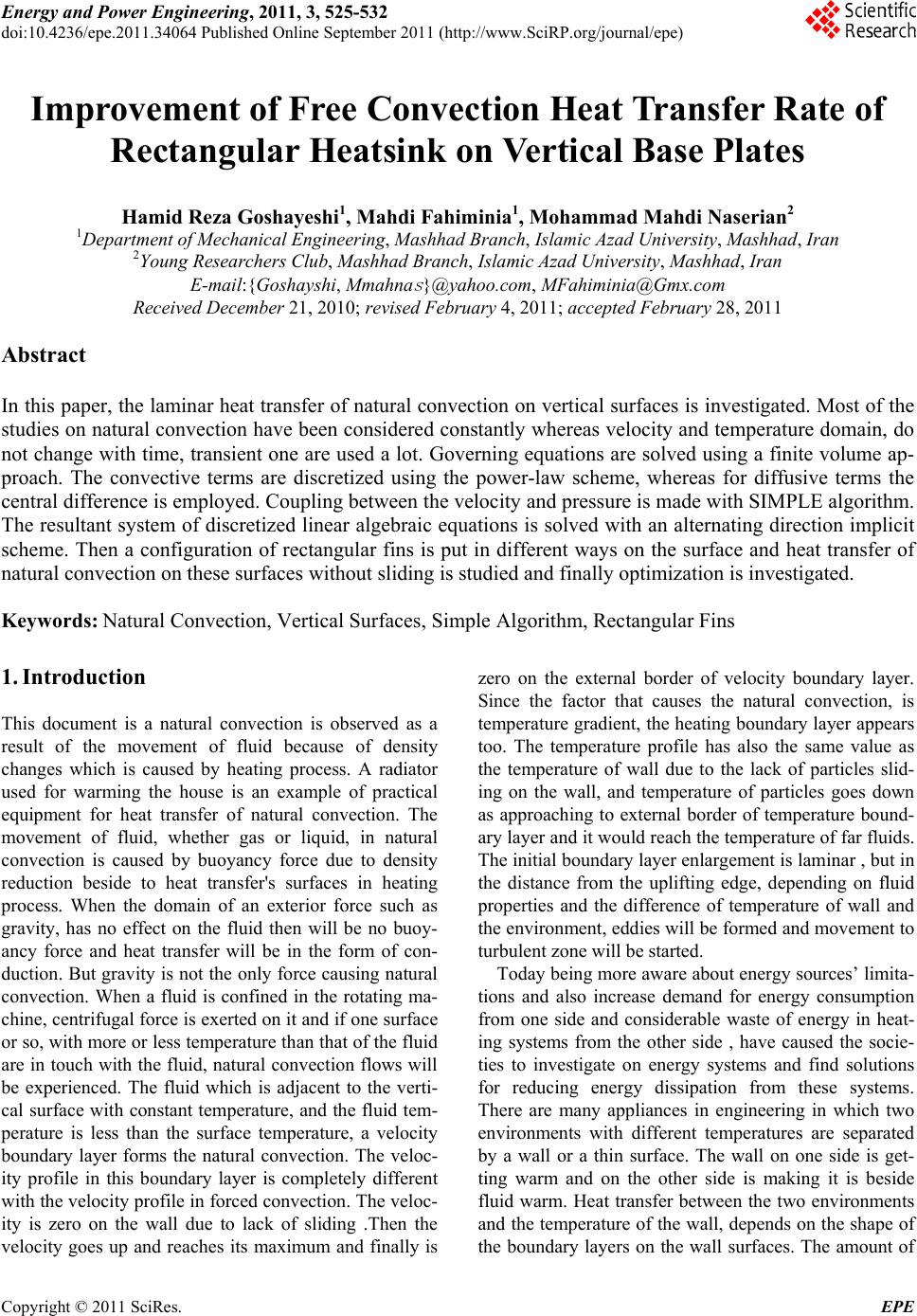
Energy and Power En gi neering, 2011, 3, 525-532
doi:10.4236/epe.2011.34064 Published Online September 2011 (http://www.SciRP.org/journal/epe)
Copyright © 2011 SciRes. EPE
Improvement of Free Convection Heat Transfer Rate of
Rectangular Heatsink on Vertical Base Plates
Hamid Reza Goshayeshi1, Mahdi Fahiminia1, Mohammad Mahdi Naserian2
1Department of Mechanical Engineering, Mashhad Branch, Islamic Azad University, Mashhad, Iran
2Young Researchers Club, Mashhad Branch, Islamic Azad University, Mashhad, Iran
E-mail:{Goshayshi, Mmahna
s
}@yahoo.com, MFahiminia@Gmx.com
Received December 21, 2010; revised February 4, 2011; accepted February 28, 2011
Abstract
In this paper, the laminar heat transfer of natural convection on vertical surfaces is investigated. Most of the
studies on natural convection have been considered constantly whereas velocity and temperature domain, do
not change with time, transient one are used a lot. Governing equations are solved using a finite volume ap-
proach. The convective terms are discretized using the power-law scheme, whereas for diffusive terms the
central difference is employed. Coupling between the velocity and pressure is made with SIMPLE algorithm.
The resultant system of discretized linear algebraic equations is solved with an alternating direction implicit
scheme. Then a configuration of rectangular fins is put in different ways on the surface and heat transfer of
natural convection on these surfaces without sliding is studied and finally optimization is investigated.
Keywords: Natural Convection, Vertical Surfaces, Simple Algorithm, Rectangular Fins
1. Introduction
This document is a natural convection is observed as a
result of the movement of fluid because of density
changes which is caused by heating process. A radiator
used for warming the house is an example of practical
equipment for heat transfer of natural convection. The
movement of fluid, whether gas or liquid, in natural
convection is caused by buoyancy force due to density
reduction beside to heat transfer's surfaces in heating
process. When the domain of an exterior force such as
gravity, has no effect on the fluid then will be no buoy-
ancy force and heat transfer will be in the form of con-
duction. But gravity is not th e only force causing natural
convection. When a fluid is confined in the rotating ma-
chine, centrifugal force is exerted on it and if one surface
or so, with more or less temperature than that of the fluid
are in touch with the fluid, natural convection flows will
be experienced. The fluid which is adjacent to the verti-
cal surface with constant temperature, and the fluid tem-
perature is less than the surface temperature, a velocity
boundary layer forms the natural convection. The veloc-
ity profile in this boundary layer is completely different
with the velocity profile in forced co nvection. Th e veloc-
ity is zero on the wall due to lack of sliding .Then the
velocity goes up and reaches its maximum and finally is
zero on the external border of velocity boundary layer.
Since the factor that causes the natural convection, is
temperature gradient, the heating boundary layer appears
too. The temperature profile has also the same value as
the temperature of wall due to the lack of particles slid-
ing on the wall, and temperature of particles goes down
as approaching to external border of temperature bound-
ary layer and it would reach the temperature of far fluids.
The initial boundary layer enlargement is laminar , but in
the distance from the uplifting edge, depending on fluid
properties and the difference of temperature of wall and
the environment, eddies will b e formed an d movement to
turbulent zon e will be started.
Today being mor e aware abou t energy sources’ limita-
tions and also increase demand for energy consumption
from one side and considerable waste of energy in heat-
ing systems from the other side , have caused the socie-
ties to investigate on energy systems and find solutions
for reducing energy dissipation from these systems.
There are many appliances in engineering in which two
environments with different temperatures are separated
by a wall or a thin surface. The wall on one side is get-
ting warm and on the other side is making it is beside
fluid warm. Heat transfer between the two environments
and the temperature of the wall, depends on the shape of
the boundary layers on the wall surfaces. The amount of